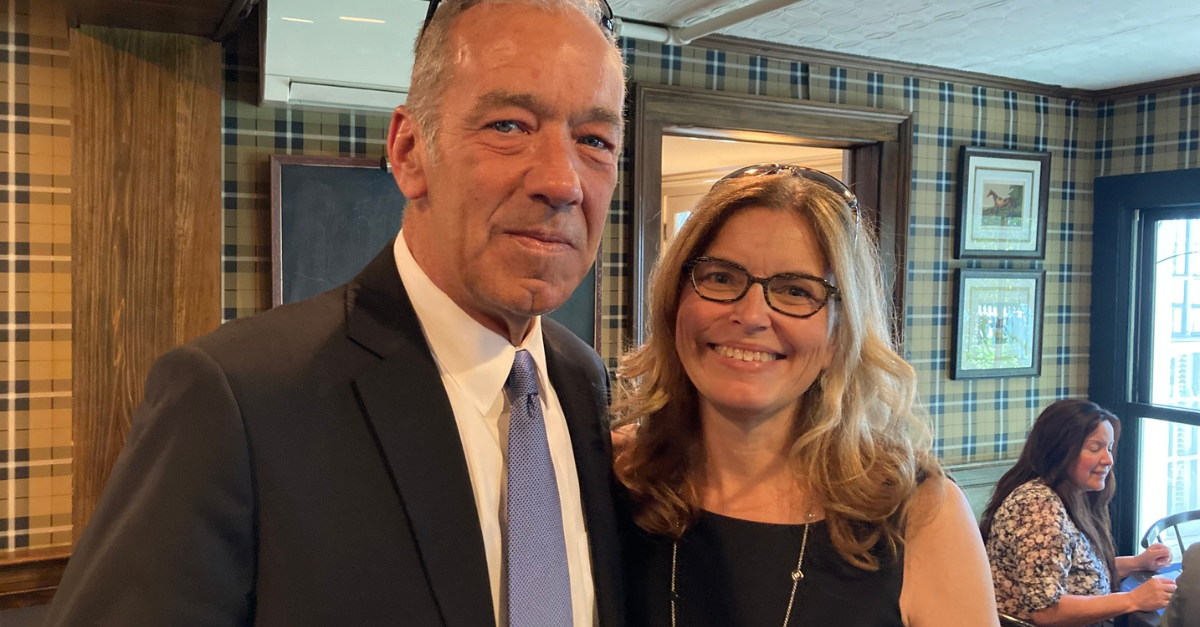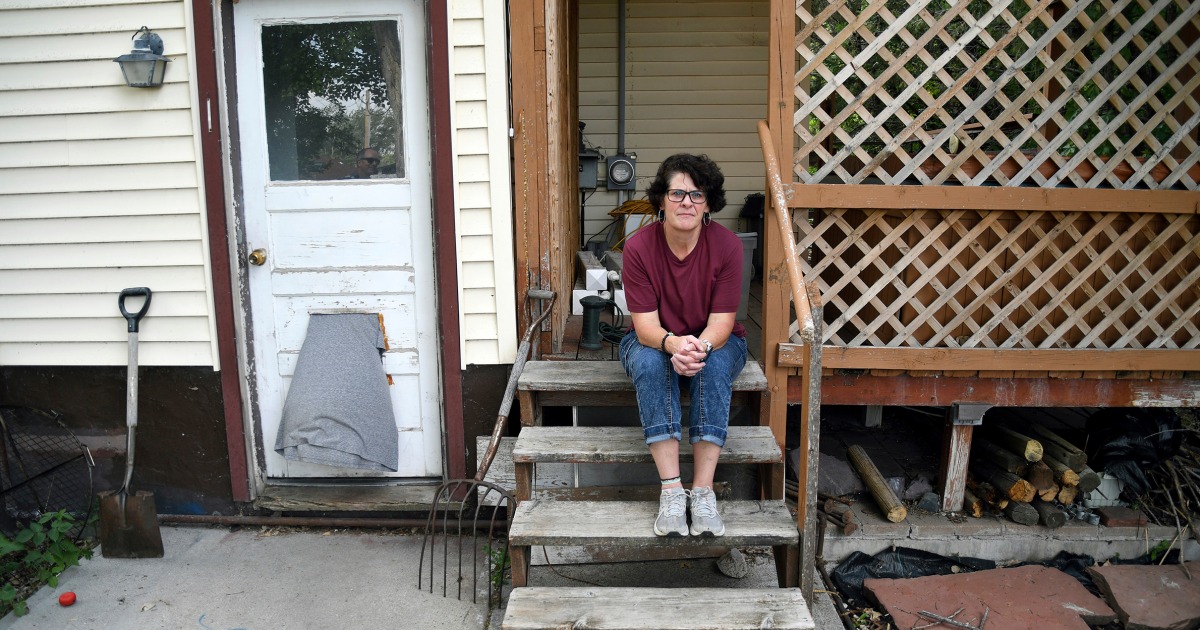Lifestyle
For $5, Radical Sewing Club teaches you to mend clothes like an anticapitalist

On a balmy summer evening, Sary Gil of Norwalk tediously repairs one of his T-shirts with red thread using decorative stitches that look like rosebuds. You wouldn’t know it, but just three weeks ago, he sewed for the first time. Ever since, on Wednesdays after work, he’s attended Radical Sewing Club in Huntington Park.
His motivation was simple: He wanted to learn to sew so he could fix damaged clothing like this T-shirt. “My first day here I learned using the practice stitching guide. They started me with the back stitch, into the split stitch, into the blanket stitch, and the flowers. … I wasn’t sure how the class was structured, so I came in blind,” he said. But once founder Scout Quiquivix explained that the club was started to fight against fast fashion and, by extension, capitalism, his interest deepened. The new skill was more in line with his morals than he realized.
Founded in 2023, Radical Sewing Club teaches practical hand sewing and mending skills every Wednesday night. For $5 (though no one is turned away for lack of funds), predominantly Southeast Los Angeles residents gather at Art Space HP, a multiuse spot with a leftist bookstore, coffee shop, art gallery and community programming area.
At the Radical Sewing Club class, Scout Quiquivix, left, shows beginners the length thread should be before putting it through a needle.
For the record:
12:07 p.m. Aug. 9, 2024An earlier photo caption stated Natasha Dominguez used a pattern to learn new stitches. It was Rosario Calatayud-Serna. The story also previously misspelled Art Space HP.
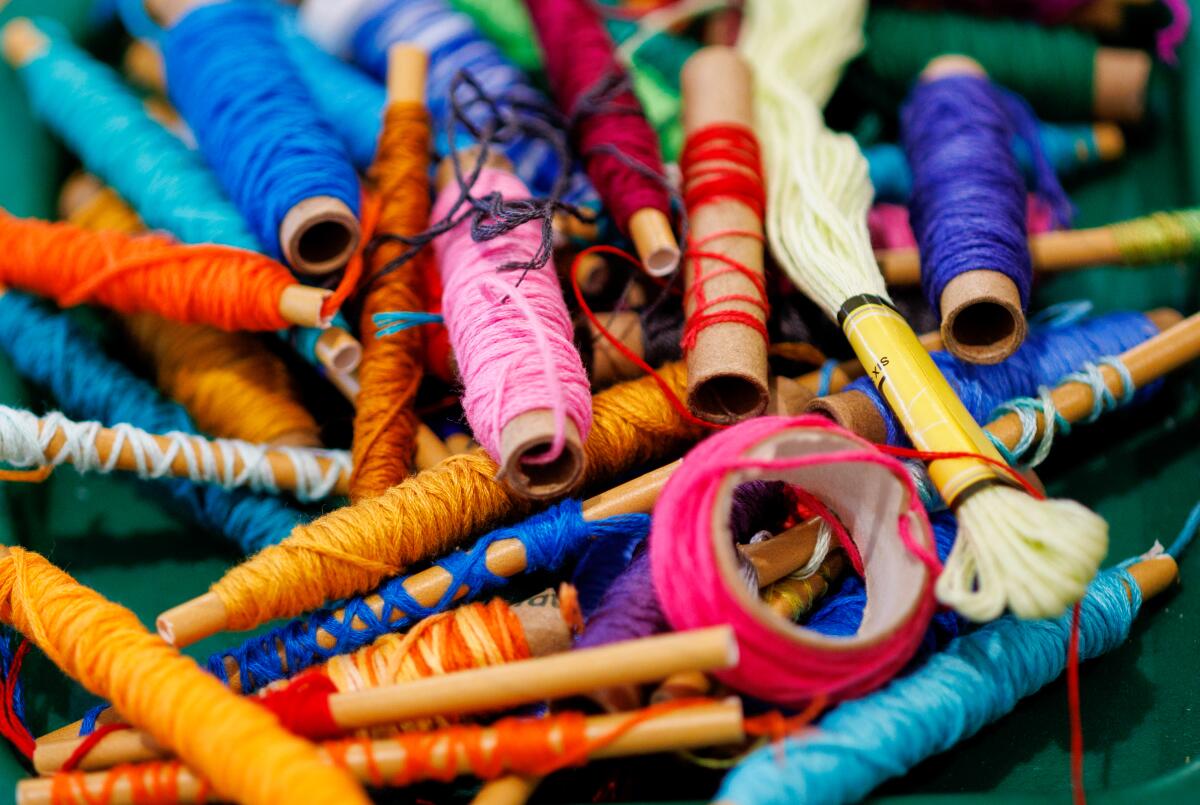
Various colors and sizes of threads on spools during the Radical Sewing Club class.
Fast fashion — when clothes are made quickly and cheaply to meet rapidly shifting trends — has been on the rise for years. But recently, so has resistance to it. Shein, a brand synonymous with fast fashion and beloved by Gen Z, updates its website with 10,000 new pieces per month, according to NPR, testing what shoppers want and then deciding what to produce in mass quantities. Shein describes this strategy as being “on demand,” but some discerning shoppers call it “ultrafast fashion.”
The Radical Sewing Club is among a growing number of Los Angeles communities preaching sustainability in fashion. Others are Suay L.A., which used to offer mending services in the past and currently offers community dyeing services (between $5 and $50 per dyed item), and Other Lives Studios, which offers classes in upcycling practices like fabric painting and decorative mending ($50-plus per class).
Back at the Radical Sewing Club meeting, a dozen sewers and hopefuls gathered around a square of shared tables. Some are here for the first time, while others, like Gil, have become regulars. Due to the fluctuating flow of attendees, there is no single lesson for each meetup. The $5 suggested fee covers materials like needles, thread, fabric for patching and more — some of which Quiquivix purchases, some of which has been donated.
First-timers can use provided embroidery hoops to practice a variety of stitching techniques. Once they’re comfortable, they can practice those stitches on clothing they bring in to mend. At this gathering, Quiquivix paces among attendees, teaching how to thread a needle (“Make sure the string is as long as your hand to your shoulder”) and answering questions, all with rescue dog Cinnamon in a pet carrier backpack.
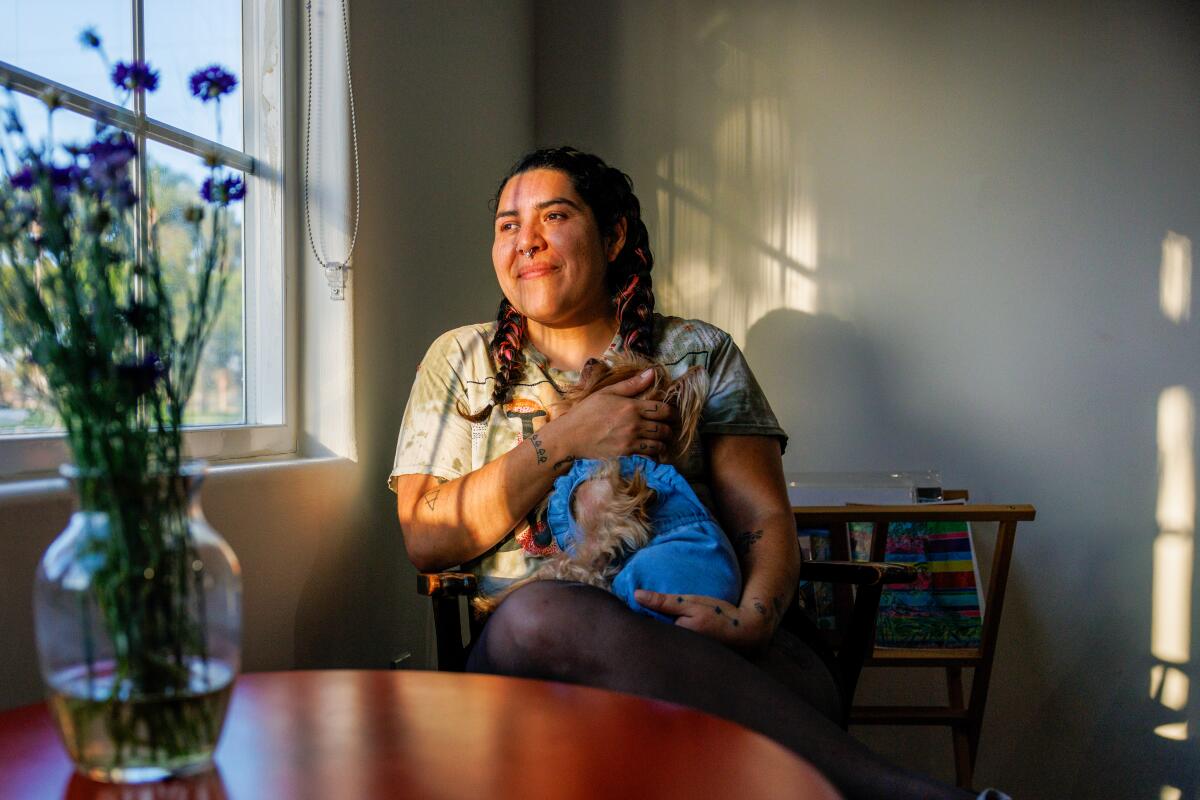
Scout Quiquivix, with their small dog Cinnamon, runs the Radical Sewing Club.
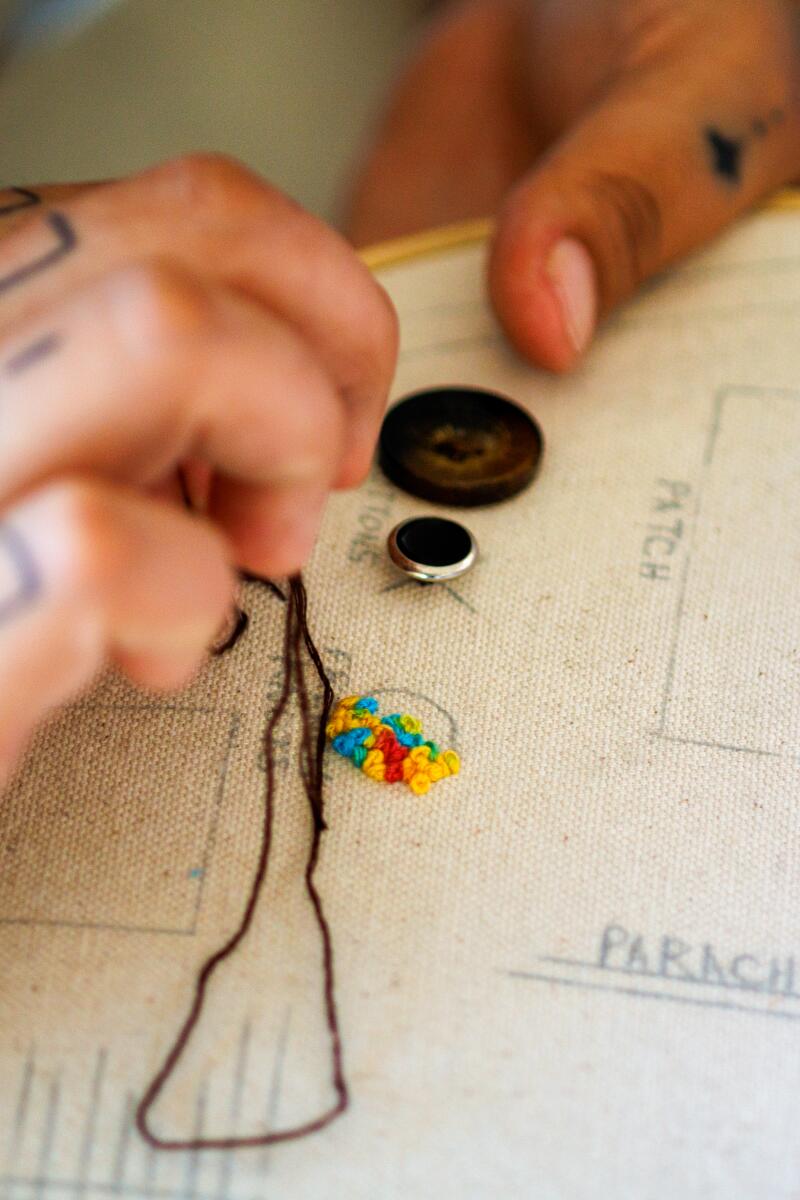
Scout Quiquivix uses a template to show beginners different stitch techniques.
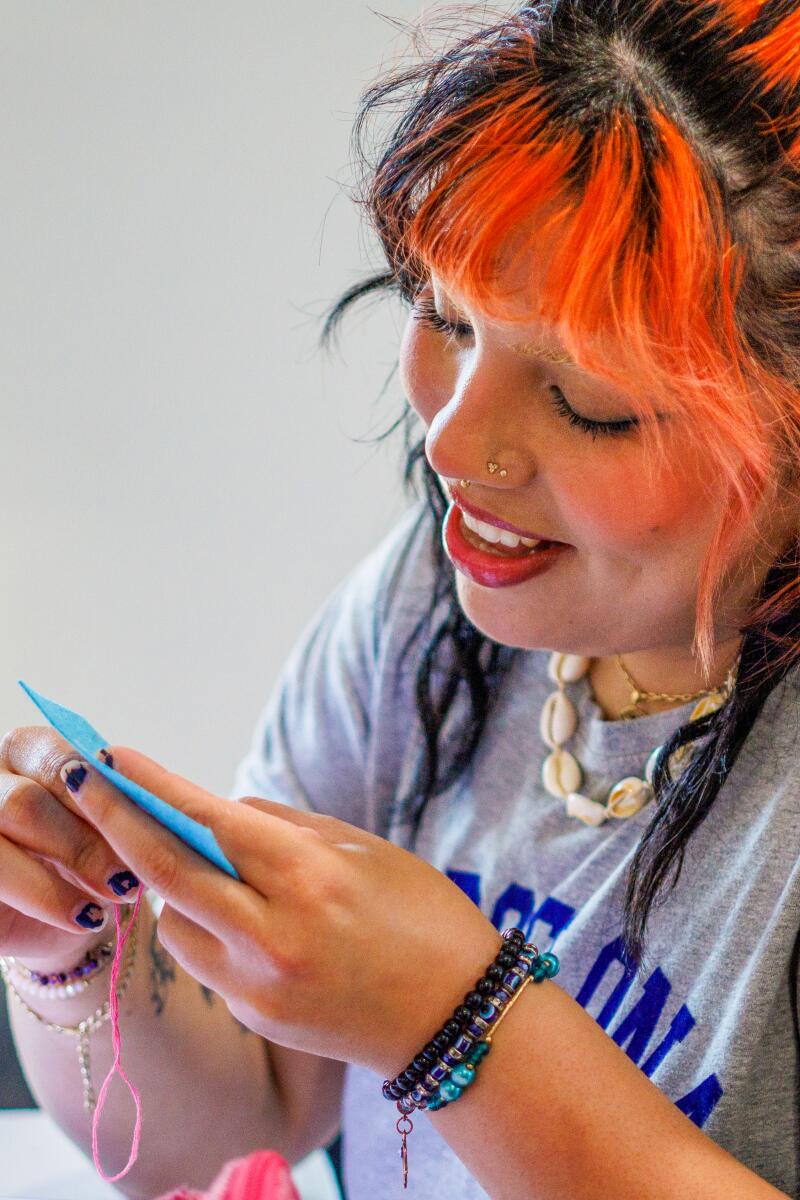
Veronica Tadeo of Los Angeles works on a sewing design at the Radical Sewing Club.
Brenda Ceja of Whittier brought in a ripped pair of pants for her second visit to Radical Sewing Club. Before attending, she had no sewing experience. “I think this is very important because it’s a life skill that’s not being taught to people anymore. I can teach others the skills I learn here. It has a ripple effect, ” she said.
This rings true for Quiquivix, who works as a manager of a thrift store by day and grew up in a suburb of Pomona. They learned to mend, sew and buy secondhand from their mother. During the pandemic, they discovered social media videos of creative embroidery used for not just design but repair. Quiquivix initially sought commission work mending others’ clothing but then decided to channel their experience and learned patience from working at youth summer camps to teach a class.
The radical element of the club is rooted in anticapitalist values. “The fact that we’re repairing our clothes in a highly capitalist society is radical. It’s radical to fix something versus throwing it away and buying something new,” said Quiquivix. This mission is more apparent to some attendees than others, but Quiquivix doesn’t mind. “If I can just get somebody to come in and learn how to sew and learn how to repair their clothes, and that’s all that they got from it, they’re still going to go home and repair their clothes and they’re still doing something anticapitalist,” they said.
Matthew Gardea and Sofia Guevara of Downey joined Genevieve Quiquivix, Scout’s wife, at a table. Gardea and Guevara, who found the club on Instagram and have attended once before, are working on embroidering a decorative patch with the Radical Sewing Club logo. Genevieve Quiquivix is using red, green and yellow thread to create a design to repair holes in the heel of a sock.
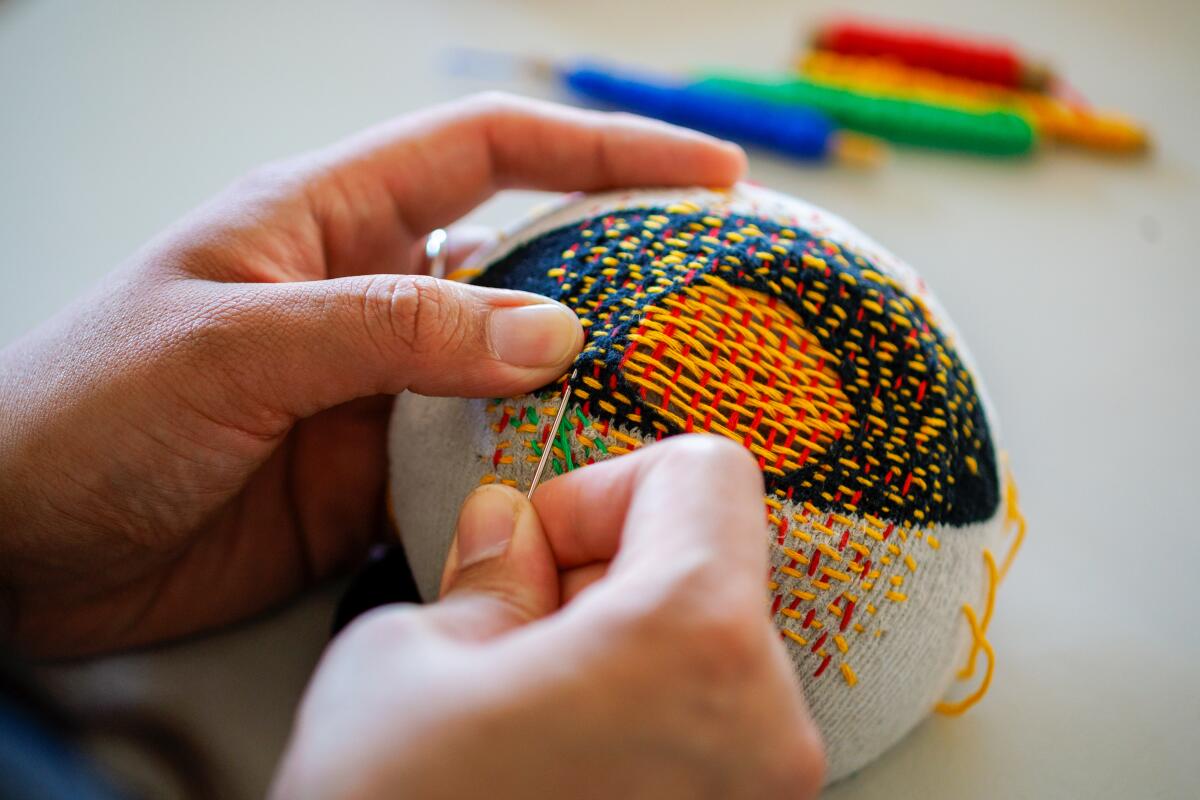
Genevieve Quiquivix darns a sock using a weave pattern.
“There’s been a stigma in the past that if you do this [mending] you’re poor. This breaks down those walls,” said Genevieve Quiquivix. Guevara agrees: “In school, when I’d wear secondhand pants that I altered so they’d fit me, kids would make fun of me. I’m glad this is normalized. It’s fun to fix your clothes.”
Amanda Tapia, a worker-owner of FTP Cafe, also inside Arts Space HP, believes Radical Sewing Club is critical for the Latino community in Southeast L.A.. “A lot of us grew up with abuelas where this skill was so natural to them. As children of immigrants being forced into assimilation, we’re claiming these skills again. … We’re learning ways to fight capitalism, stay in alignment with our values and maintain our culture in a more radicalized way, which I think is beautiful.”
As attendance grows, Scout Quiquivix hopes to enlist a second teacher. In the meantime, regular attendees are teaching their newfound skills to first-timers. “It’s the most beautiful thing in the whole world,” Quiquivix said.
Follow @radicalsewingclub on Instagram for more information or join every Wednesday at 6:30 p.m. at Art Space HP: 3382 E. Florence Ave., Huntington Park.

Lifestyle
A dark musical comedy about witches has Ukraine enthralled. Here's why

A scene from a Ukrainian production of The Witch of Konotop. At the window, Olena, played by Mariia Rudynska, is the love interest of the main character but does not love him back. And a three-witch chorus is seen right.
Ivan Franko Theater
hide caption
toggle caption
Ivan Franko Theater
KYIV, Ukraine — Witches are having a moment in Ukraine. Both feared and revered, these beings are thought to possess supernatural powers that can be used for good and bad. Over the centuries, witches have been blamed for all kinds of things happening to Ukrainians: droughts, floods, diseases — even falling in love and starting wars.
Now they have taken center stage in a dark musical comedy titled The Witch of Konotop, with performances selling out all summer at the historic Ivan Franko Theater in the capital Kyiv.
Folklore brought to life
Based on the 1833 satirical fiction by Ukrainian writer Hryhorii Kvitka-Osnovianenko, the story pokes fun at Ukrainian literature’s tendency to focus on sadness and tragedy. It takes place in the 1600s and follows the main character, Zabryokha, a Cossack military leader, in his unsuccessful journey to do away with witches whom he blames for his misfortunes.
Throughout the fast-paced, witty hour-and-a-half production, the audience is treated to beautifully detailed Ukrainian folk costumes and stunning vocals set to traditional Ukrainian music.

Main character Zabryokha, played by Nazar Zadniprovskyi, and his cunning assistant, Pistryok, played by Mykailo Kukuyuk, spend much of the play blaming others for their misfortunes and conspiring. They eventually turn to a witch for help, in hopes she can change their fates.
Ivan Franko Theater
hide caption
toggle caption
Ivan Franko Theater
There is rejection, there is love.
And there is, of course, a witch hunt.
Additionally, in a twist that echoes today, the main characters receive orders to join a campaign to fend off an overreaching czarist Russia.

One play, many takeaways
Life under a sinister Russian threat might be the most obvious theme from this play. Yet, a quick survey of the cast and audience at a recent performance reveals the production’s true flexibility.
“Don’t kill women, don’t mess with women,” says actress Kateryna Artemenko, who plays one of the townswomen mistaken for a witch. She spoke to NPR backstage before the show.
“No, it is not a joke, of course,” Artemenko says. “The main message is about people trying to fool their destiny, but destiny will find them.”
Actor Nazar Zadniprovskyi, who plays the ill-fated Cossack commander Zabryokha, views this play as a lesson in avoiding responsibility. The two lead characters avoid going to military drills so they don’t have to go to war, he says, and many people see a parallel with Ukrainian men dodging conscription today.
Zadniprovskyi also attributes the play’s popularity to the clips that have gone viral on social media. There, Ukrainians from all walks of life weigh in.

Audience member Markian Halabala of Kyiv says seeing buzz about the play online is what first piqued his interest. He says it was difficult to get tickets because the play sells out so quickly. When he finally saw it, he felt the message was that you shouldn’t interfere in God’s will — like Zabryokha does in the play when he asks a witch to cast a spell on a woman to make her fall in love with him, even though she loves someone else. Halabala likens it to Russian President Vladimir Putin trying to interfere in Ukraine’s path forward as an independent nation.
However, theatergoer Olha Vasylevshka of Kharkiv says she thinks the play is about love.
“Of course if the love is true, it doesn’t need any outside assistance,” she says, laughing. “But if the love is not true, nothing can help it, not even a witch.”
Sold-out shows
Critics say audiences’ many interpretations of The Witch of Konotop are just one reason it’s been so popular.
Ivan Franko Theater press liaison Olena Kyrychenko-Povolocka told NPR the production has filled their nearly 800-seat house for every performance this summer and she expects to continue that success. The play has dates on its website through mid-September.
Another reason for the play’s popularity may be its ties to not only Ukrainian folklore, but also to Ukraine’s real-life town of Konotop known for witches.

Near the beginning of Russia’s full-scale invasion in 2022, a video surfaced online of a woman shouting at a Russian soldier sitting atop a tank.
“Do you even know where you are?” the woman shouts in a raspy voice. “You’re in Konotop — every second woman here is a witch.”
She goes on to warn the soldier he will never get an erection again.
The video went viral in Ukraine, not just because of the woman’s defiance, but also because the video was from Konotop and Ukrainians immediately got the reference.

Witches have long been a staple of Ukrainian folklore. Believed to have other-worldly powers, they were often scapegoats for when bad things happened — such as droughts, floods or disease. In the play, the witches — seen here played by Anna Rudenko, Anastasiia Rula and Kateryna Artemenko — serve as a chorus and a plot device.
Ivan Franko Theater
hide caption
toggle caption
Ivan Franko Theater
There’s been an overall push to celebrate Ukrainian culture and literature since Russia’s invasion. Putin has repeatedly said victory means nothing short of Ukraine not just losing its sovereignty — but also its identity.
Ukrainians’ renewed interest in their own culture has driven them back to theaters. Almost all functioning theaters in the country have returned to selling tickets to full houses, according to Olha Baibak with the National Union of Theater Workers of Ukraine.
“There is a growing interest in the theater throughout the country,” Baibak wrote in an email to NPR. “New audiences have come, people go for communication, for therapy, to live some kind of experience.”
She says they also come to get away from reality.
Performing also offers actors an escape.
Actor Mykhailo Kukuyuk, who plays the character Pistryak, the main character’s cunning assistant, says it’s sometimes difficult to block out the challenges and horrors of war happening outside the theater. But performing is an honor that reminds him what he believes Ukrainians are fighting for.
“For theater, for good-looking, beautiful women. It’s the details, the sparks that make us alive — it’s hard to put into one sentence,” he says.
Polina Lytvynova contributed to this report from Kyiv.
Lifestyle
Sunday Puzzle: Rhyming destinations

Sunday Puzzle
NPR
hide caption
toggle caption
NPR
On-air challenge: Every answer is a two-word name of a place in the U.S. or elsewhere in the world where you might visit. I’ll give you rhymes for the two words. You name the places.
Ex. Right Spouse –> WHITE HOUSE
- Ski Vest (hint: Florida)
- Greater Stake (hint: Oregon)
- Call Sheet (hint: New York)
All the rest are foreign …
- Rifle Power
- Pig Pen
- Rock Cress
- Dead Air
- Eight Ball
- Tape Down
- Fourth Hole (hint: only a small number of people have been here)
Last week’s challenge: Last week’s challenge came from listener Greg VanMechelen, of Berkeley, Calif. Think of a popular food item in six letters. Substitute the last two letters with one K to make a common five-letter word in which none of the letters are pronounced the same as in the six-letter food. What food is this?
Challenge answer: Quiche —> quick
Winner: Eli Shear-Baggish of Arlington, Mass.
This week’s challenge: This week’s challenge comes from listener Peter Collins, of Ann Arbor, Michigan. Think of a famous movie star — first and last names, nine letters in all. The third, fourth, fifth, seventh, and eighth letters, in order, name a profession. The star’s last name is something that this profession uses. Who is the movie star and what is the profession?
Submit Your Answer
If you know the answer to the challenge, submit it here by Thursday, August 22nd at 3 p.m. ET. Listeners whose answers are selected win a chance to play the on-air puzzle. Important: include a phone number where we can reach you.
Lifestyle
'Godfather Part II' Star John Aprea Dead at 83
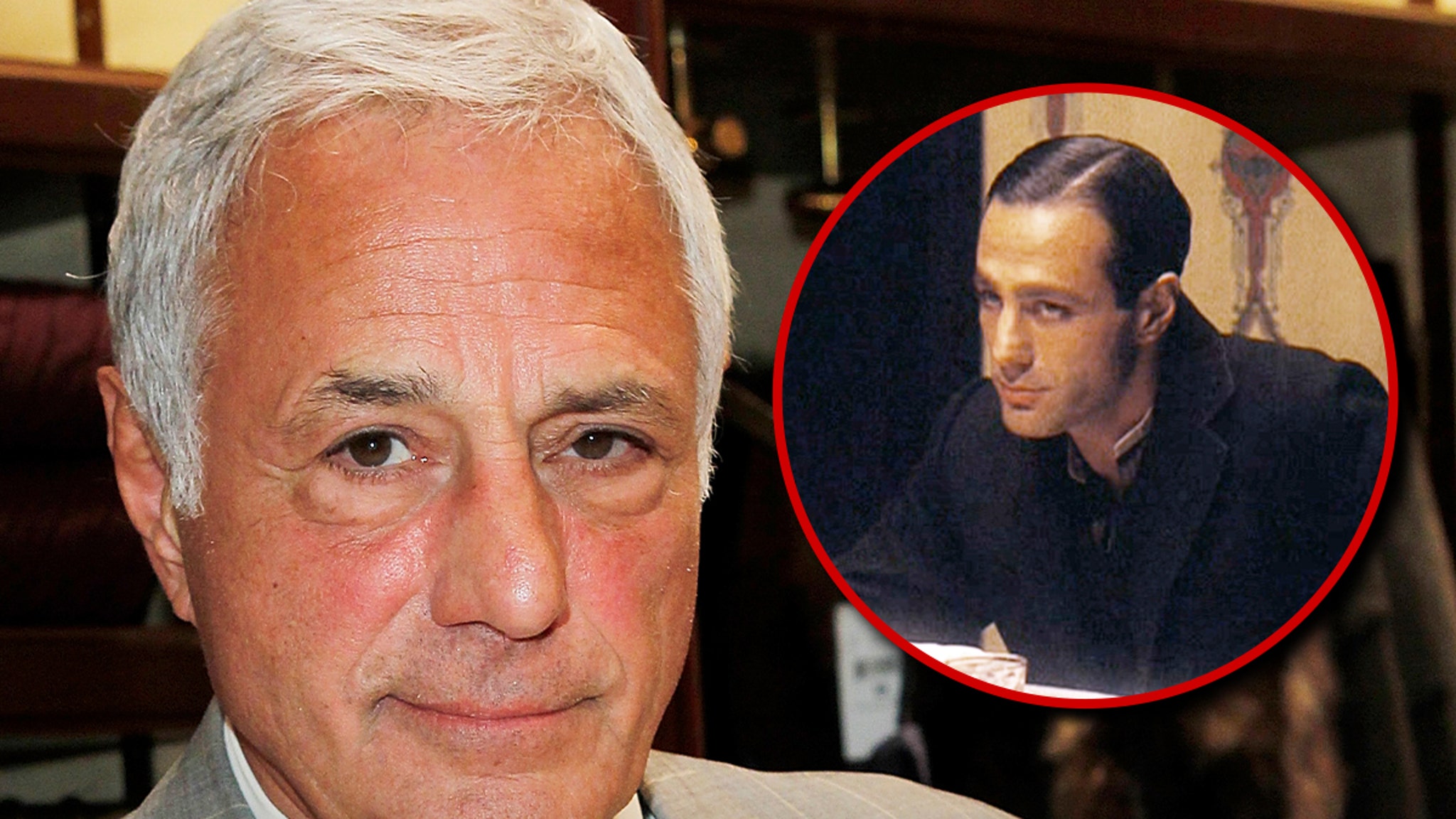
John Aprea, one of the stars of “The Godfather Part II” and “Full House,” is dead of natural causes … TMZ has learned.
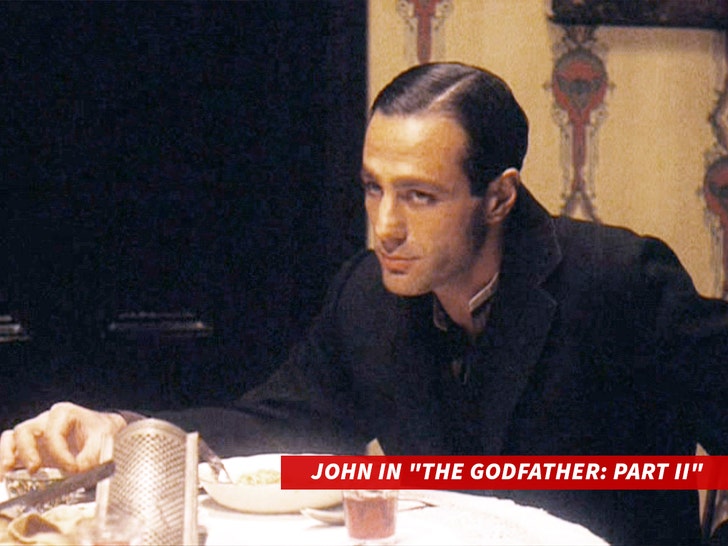
His manager Will Levine tells us … the actor passed away on August 7, at his home in Los Angeles, with family members by his side.
John called his role as young Salvatore Tessio his greatest career achievement. He had originally auditioned to be Michael Corleone in the OG ‘Godfather,’ which of course went to Al Pacino. But, Francis Ford Coppola called back Aprea for the 1974 sequel.
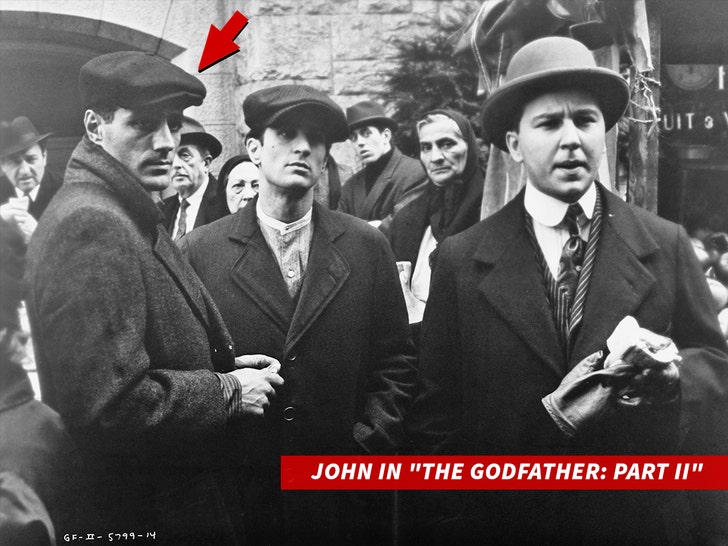
John’s successful career actually started with another classic, as he made his acting debut in 1968 in Steve McQueen‘s “Bullitt.”
In the ’80s and ’90s he appeared on several TV shows, including “Knots Landing,” “Falcon Crest,” “The Gangster Chronicles” and “Full House” — how’s that for range?!

Aprea played Nick Katsopolis, the father of John Stamos‘ Uncle Jesse character — and he returned in that role for the reboot, “Fuller House.”
He had a couple of stints in Daytime TV, too, appearing on “Another World” for several years in 2 different roles.
Waiting for your permission to load the Instagram Media.
His friend and former “Knots Landing” costar Paul Carafotes posted a touching tribute to Aprea, saying “Many will miss this man.”
John was 83.
RIP
-

 Ohio4 days ago
Ohio4 days agoOhio taxpayers sent families $966 million for private school tuition: Capitol Letter
-

 News1 week ago
News1 week agoNewly released video shows chaos and confusion after Trump assassination attempt
-

 World6 days ago
World6 days agoWhat could an EU Commissioner do to tackle the housing crisis?
-

 Politics1 week ago
Politics1 week agoTrump campaign frames election is 'complete contrast' against Harris record
-

 Politics1 week ago
Politics1 week agoTim Walz 'misspoke' about using weapons ‘in war,' Harris campaign says: report
-

 Politics1 week ago
Politics1 week agoProgressive women's groups silent on second gentleman Doug Emhoff's affair
-

 News1 week ago
News1 week agoPhotos: Family of Michael Brown Jr. marches on Ferguson 10 years later
-

 Politics1 week ago
Politics1 week agoBiden hunkers down at Delaware beach house after only public event of the week
